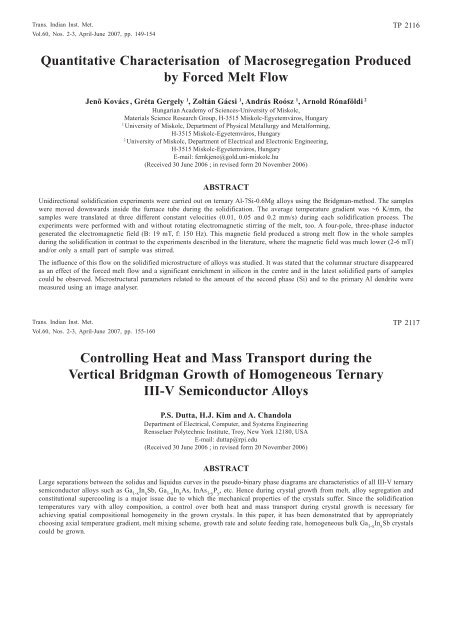Vol.60, Nos. 2-3 - Indira Gandhi Centre for Atomic Research
Vol.60, Nos. 2-3 - Indira Gandhi Centre for Atomic Research
Vol.60, Nos. 2-3 - Indira Gandhi Centre for Atomic Research
You also want an ePaper? Increase the reach of your titles
YUMPU automatically turns print PDFs into web optimized ePapers that Google loves.
Trans. Indian Inst. Met.<br />
<strong>Vol.60</strong>, <strong>Nos</strong>. 2-3, April-June 2007, pp. 149-154<br />
TP 2116<br />
Quantitative Characterisation of Macrosegregation Produced<br />
by Forced Melt Flow<br />
Jenõ Kovács , Gréta Gergely 1 , Zoltán Gácsi 1 , András Roósz 1 , Arnold Rónaföldi 2<br />
Hungarian Academy of Sciences-University of Miskolc,<br />
Materials Science <strong>Research</strong> Group, H-3515 Miskolc-Egyetemváros, Hungary<br />
1<br />
University of Miskolc, Department of Physical Metallurgy and Metal<strong>for</strong>ming,<br />
H-3515 Miskolc-Egyetemváros, Hungary<br />
2<br />
University of Miskolc, Department of Electrical and Electronic Engineering,<br />
H-3515 Miskolc-Egyetemváros, Hungary<br />
E-mail: femkjeno@gold.uni-miskolc.hu<br />
(Received 30 June 2006 ; in revised <strong>for</strong>m 20 November 2006)<br />
ABSTRACT<br />
Unidirectional solidification experiments were carried out on ternary Al-7Si-0.6Mg alloys using the Bridgman-method. The samples<br />
were moved downwards inside the furnace tube during the solidification. The average temperature gradient was ~6 K/mm, the<br />
samples were translated at three different constant velocities (0.01, 0.05 and 0.2 mm/s) during each solidification process. The<br />
experiments were per<strong>for</strong>med with and without rotating electromagnetic stirring of the melt, too. A four-pole, three-phase inductor<br />
generated the electromagnetic field (B: 19 mT, f: 150 Hz). This magnetic field produced a strong melt flow in the whole samples<br />
during the solidification in contrast to the experiments described in the literature, where the magnetic field was much lower (2-6 mT)<br />
and/or only a small part of sample was stirred.<br />
The influence of this flow on the solidified microstructure of alloys was studied. It was stated that the columnar structure disappeared<br />
as an effect of the <strong>for</strong>ced melt flow and a significant enrichment in silicon in the centre and in the latest solidified parts of samples<br />
could be observed. Microstructural parameters related to the amount of the second phase (Si) and to the primary Al dendrite were<br />
measured using an image analyser.<br />
Trans. Indian Inst. Met.<br />
<strong>Vol.60</strong>, <strong>Nos</strong>. 2-3, April-June 2007, pp. 155-160<br />
TP 2117<br />
Controlling Heat and Mass Transport during the<br />
Vertical Bridgman Growth of Homogeneous Ternary<br />
III-V Semiconductor Alloys<br />
P.S. Dutta, H.J. Kim and A. Chandola<br />
Department of Electrical, Computer, and Systems Engineering<br />
Rensselaer Polytechnic Institute, Troy, New York 12180, USA<br />
E-mail: duttap@rpi.edu<br />
(Received 30 June 2006 ; in revised <strong>for</strong>m 20 November 2006)<br />
ABSTRACT<br />
Large separations between the solidus and liquidus curves in the pseudo-binary phase diagrams are characteristics of all III-V ternary<br />
semiconductor alloys such as Ga 1-x<br />
In x<br />
Sb, Ga 1-x<br />
In x<br />
As, InAs 1-y<br />
P y<br />
, etc. Hence during crystal growth from melt, alloy segregation and<br />
constitutional supercooling is a major issue due to which the mechanical properties of the crystals suffer. Since the solidification<br />
temperatures vary with alloy composition, a control over both heat and mass transport during crystal growth is necessary <strong>for</strong><br />
achieving spatial compositional homogeneity in the grown crystals. In this paper, it has been demonstrated that by appropriately<br />
choosing axial temperature gradient, melt mixing scheme, growth rate and solute feeding rate, homogeneous bulk Ga 1-x<br />
In x<br />
Sb crystals<br />
could be grown.
















